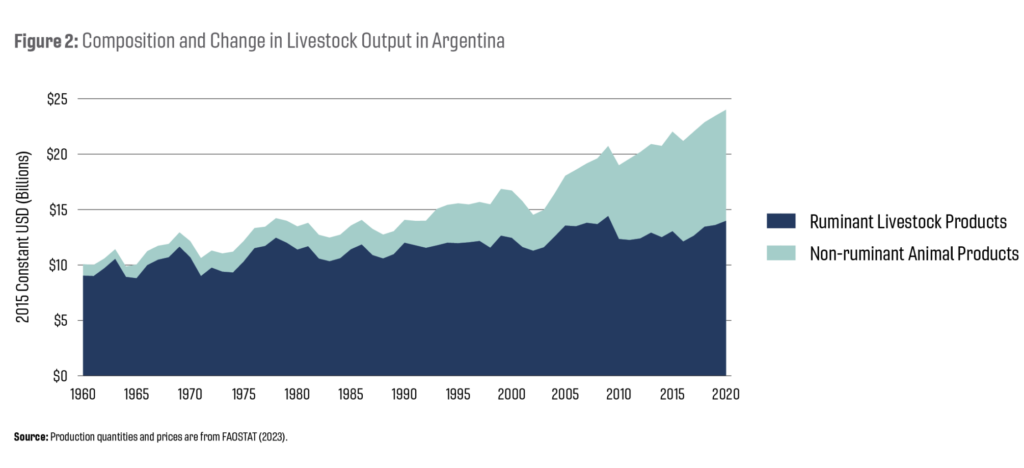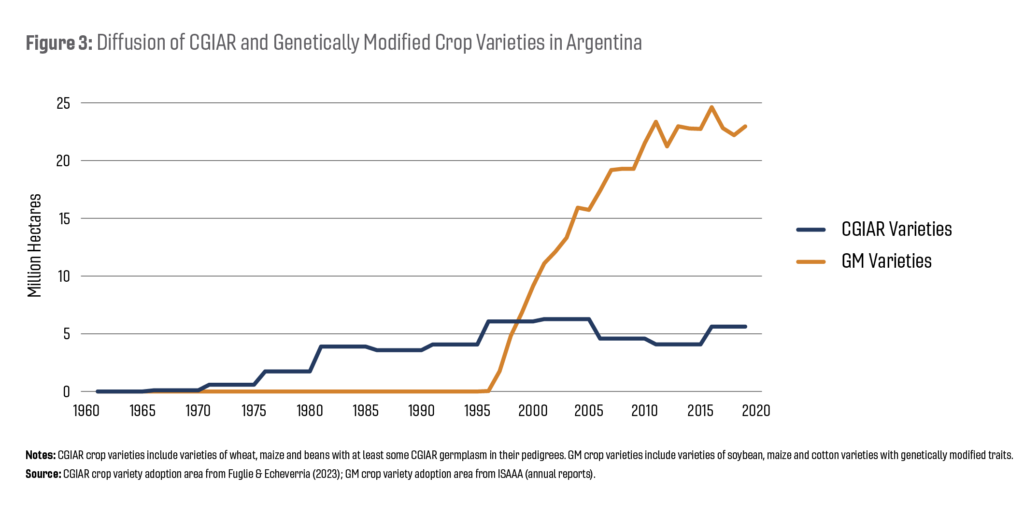Argentina is a competitive global exporter of both crops and animal products, with agricultural exports totaling over $53 billion in 2022 (Trade Data Monitor, 2023). To support agricultural competitiveness, Argentina has maintained one of the most prominent public agricultural research systems in Latin America and the Caribbean alongside Brazil and Mexico (Echeverria, 2021). However, agricultural productivity growth in Argentina has been uneven over time and across commodities. This article analyzes changes in Argentina’s agricultural productivity since the 1960s, emphasizing contributions of public investment in agricultural research and development. This article also highlights other developments including private sector innovations in biotechnology, land and capital use, and the policy environment, which may contribute to agricultural productivity growth.
Argentina as a competitive agricultural producer

The export value of Argentina’s crops has more than tripled since 2002. In 2021, Argentina was the largest exporter of soybean oil and meal, the second largest exporter of corn, and the fourth largest exporter of soybeans by value (Padilla et al., 2023). Argentina is also a major global producer of beef (Ufer et al., 2023). Other main commodities for export include wheat, sunflower, and milk.
Argentina has experienced significant growth in both crop and livestock production since 1960. Between 1960 and 2020, the value of the country’s crop production rose from around $7.5 billion to over $45 billion (Figure 1) and output growth was an average of 3 percent per year. Oilseed production has represented an increasing share of Argentina’s crop output. In 1960, oilseeds represented approximately 10 percent of crop output compared to 45 percent in 2020. Cereal output also increased over time, but at a lower rate than oilseeds, while horticultural and other crop outputs remained relatively stable.
Livestock production in Argentina grew at a slower rate than crop production at 1.3 percent annually from 1960 to 2020 (Figure 2). Output growth associated with non-ruminant animal products has increased over the past four decades, while ruminant-related output has remained stable. Growth in non-ruminant output is important because it implies an increased need for animal feed composed of both grain and oilseeds. However, it is important to note that while Argentina traditionally relied on grass-fed production systems for cattle, there has been increased use of feedlots – an intensive production system that aims to grow or fatten cattle quickly – and increased use of animal feed in ruminant production as well (Lence, 2010).
Productivity growth 
Agricultural output growth in Argentina has resulted primarily from gains in agricultural productivity rather than adding more resources to production. Recent data on total factor productivity (TFP) growth in Argentina reveals that agricultural productivity in Argentina grew at an average annual rate of 1.49 percent from 1961 to 2020 (Saini & Lema, 2015). During this period, agricultural output grew at an average annual rate of 1.99 percent. This means that TFP accounted for 75 percent of output growth, while increases in land, labor, and capital inputs accounted for only 25 percent.
Productivity growth in Argentina has been uneven over time. During the period between 1961 and 1990, TFP growth was 2.32 percent per year, leading to positive output growth even as input use was shrinking. This suggests that during this period, new agricultural technologies, including improved varieties of grains, supported increased production with fewer resources. However, in more recent decades, agricultural output growth has been driven by more intensive use of inputs in agricultural production. From 1991 to 2020, TFP growth was 0.54 percent per year and only accounted for 25 percent of output growth. The increased use of land, labor, and capital accounted for 75 percent of the growth in agricultural output. This was especially true for the crop sector, where growth in input use was 2.8 percent annually. Technological change may have contributed to increased input use, as the application of no-till – growing crops without disturbing the soil through tillage – allowed cropland to be farmed more intensively and brought previously marginal pasture and uncultivated areas into production. At the same time, new genetically modified (GM) crop varieties that could tolerate herbicides were adopted. This increased the application of chemical herbicides. Though, the insect resistance GM trait may have reduced reliance on some insecticides.
The impact of public and private research on the trajectory of Argentine agriculture
Public research and development activities not only create new technologies but also help to adapt existing technologies to local agroecological conditions to improve productivity. In Argentina, the National Institute of Agricultural Technology (INTA) is the major vehicle for conducting public agricultural research and development as well as extension activities. In 2006, INTA represented nearly 60 percent of public agricultural research spending in Argentina, with most other funding being provided by higher education institutions (Stads, 2008). Additionally, INTA extension and training activities encourage the adoption of productivity-enhancing technologies by producers.
Focusing on INTA funding from 1961 to 2020, regression estimates find a positive relationship between public agricultural research expenditure and agricultural TFP growth in Argentina. We estimate that over the long term, public investment in agricultural research and development has had an internal rate of return of 37 percent per year. This translates into a benefit-cost ratio of 17:1; in other words, assuming a 5 percent real discount rate, each one peso investment by public institutions like INTA generated approximately 17 pesos in economic value over a 50-year time period.
In addition to public institutions like INTA, other sources of new technologies for Argentina include the private sector and CGIAR (formerly the Consultative Group for International Agricultural Research), a system of international agricultural research centers that conduct basic research focused on low-income countries.
Private investment in new GM crops plays a significant role in Argentine agriculture. The first GM varieties of soybeans were introduced in Argentina in 1996, and within five years, had spread to more than 90 percent of production – a faster diffusion rate than was observed in the United States (Qaim & Traxler, 2005). One factor contributing to the rapid expansion of GM soybean use in Argentina was the availability of the technology under weaker intellectual property institutions that led to lower markups for GM seeds (OECD, 2019). Reduced costs and broader availability were associated with higher welfare gains accruing to soybean producers in Argentina when compared with producers implementing the technology globally (Qaim and Traxler, 2005).

Figure 3 plots the share of the harvested land area planted for CGIAR and GM crop varieties between 1960-2020. Improved varieties of crops made available through collaborations with CGIAR centers were introduced around 1970 and represented around 20 percent of the harvested area (~3.9 million hectares) by 1981. Adoption of improved varieties of wheat significantly contributed to increased yields and value of production in Argentina. The CGIAR-related crop germplasm may have increased the value of Argentina’s crop production by as much as $2.7 billion/year (Fuglie & Echeverria, 2023). In Argentina, semi-dwarf wheat varieties were adopted in approximately 95 percent of the wheat production area by 1983 (Anderson et al., 1988). GM varieties were first introduced for soybeans in 1996 and later for corn and cotton. They were widely adopted, representing 36 percent of the total harvested area of all crops by 2000 and 62 percent by 2020. Regression analysis suggests that each 1 percent share of cropland in GM crop varieties raised agricultural TFP by 0.1 percent — for Argentina’s $29.1 billion agricultural sector (2016-20 average, in 2015 US dollars), this amounts to $1.8 billion/year in increased value-added.
Other key developments affecting Argentine agricultural growth
Intensification of land and capital inputs, including machinery and equipment, helped increase yields in Argentina (Sturzenegger & Salazni, 2007). From 1995 to 2020, the agricultural capital stock in Argentina more than doubled, increasing from $38 to $78 billion (USDA-ERS, 2022). These trends are associated with increased production of oilseed and grain crops, which are relatively more capital-intensive compared with other horticultural crops.
Agricultural land use patterns in Argentina also changed over time, reflecting the growing importance of crops over livestock and the conversion of pastures to cropland (Figure 4). Total cropland in Argentina grew from 19 million hectares in 1961 to a peak of 41 million hectares in 2012, before declining to 34 million hectares by 2020. Area in permanent pastures and rangeland declined from 118 million hectares to 75 million hectares from 1961 to 2020. This decline partially reflects the conversion of grasslands to cropland, especially as new practices, such as no-till, made it profitable to cultivate areas previously deemed too marginal to sustain crop production (Trigo et al., 2009).

No-till agriculture involves planting crops without turning the soil and leaving pre-existing crop residue in the field (Manuel-Navarrete & Gallopín, 2012). Benefits of no-till include gains in short- and long-term productivity, improved soil health and erosion control, and improved water management due to increased soil organic matter (Peiretti & Dumanksi, 2014). Producers benefit from cost savings in land preparation due to reduced input costs associated with tilling (Trigo et al., 2009). However, no-till does result in some increased costs, particularly in the form of increased herbicide use to manage weeds (Manuel-Navarette & Gallopín, 2012).
No-till agriculture trials were first implemented in Argentina in the 1970s, and the adoption of the practice was rapid beginning in the 1990s. By 2011, over 23 million hectares, or 79 percent of grain production in Argentina, was under no-till (Peiretti & Dumanski, 2014). The use of no-till farming practices expanded cultivation by allowing marginal lands, which were previously used for livestock grazing, to be converted to intensive cropping systems.
The establishment of new farm organizational structures also played a significant role in increasing output in Argentina. One example is the development of planting pools, which can describe a wide variety of formal contracts between producers, investors, and other actors in the agricultural supply chain (Lence, 2010). A common example is where investors enter into rental contracts with landowners across regions to engage them in production activities (Sturzenegger & Salazni, 2007). These arrangements are often overseen by professional agricultural consultants who manage production and who have contributed to increased production in the Pampas, the main crop-producing region of the country (Urcola et al., 2015). Planting pools have been successful at attracting new financial capital into agriculture, incorporating improved production practices and technologies on the farm, and using mechanisms such as insurance to manage agri-management tools better (Lence, 2010).
Policy environment for Argentine agriculture
Agricultural output and productivity growth in Argentina has occurred in the context of a complex and evolving policy environment. Prior to the 1990s, macroeconomic and trade policies were historically biased against Argentinean agriculture (Sturzenegger and Salazni, 2007). These policies included export taxes on competitive products, requirements of licenses to export products, and overvalued exchange rates, which made Argentinean agricultural products relatively more expensive for foreign consumers.
However, during the 1990s, Argentina undertook significant structural reforms and deregulated broad sectors of the economy. One major change was fixing the exchange rate to the US dollar. Deregulation for agriculture involved a variety of measures, such as eliminating export taxes and quantitative restrictions and lowering tariffs on agricultural inputs, including fertilizers, pesticides, herbicides, and machinery (Sturzenegger and Salazni, 2007).
In the early 2000s, Argentina experienced an economic crisis that resulted in a depreciation of the exchange rate and the return of export restrictions and taxes. Further instability extended into the 2010s with high levels of inflation, overvalued exchange rates, and other quantitative restrictions (Costa, 2019). These developments negatively affected agricultural prices in Argentina, driving domestic prices even lower than international prices for the major commodity groups (OECD, 2019).
Conclusion
Overall, we uncovered evidence that Argentina has experienced high returns from public agricultural research and development, which significantly contributed to TFP growth in the region. From 1961 to 2020, we found agricultural TFP grew at an annual rate of 1.49 percent, and public research and development expenditures were important factors of this growth.
These results are important for a variety of reasons. First, Argentina provides evidence of the high returns elicited from public agricultural research and development expenditures. These findings are consistent with those of other countries in the region, including Brazil, Uruguay, and Mexico (Rada & Buccola, 2012; Bervejillo et al., 2012; Fernandez-Cornejo & Shumway, 1997). Second, the returns to public investment in agricultural research and development in Argentina accrue even with significant private sector investment in agricultural technologies, including GM seed varieties and other investments through CGIAR. This suggests that public and private investments are complementary and may serve to provide farmers and ranchers with a broader set of tools to improve on-farm productivity. Third, policy and economic instability, especially surrounding exchange rates and export taxes, have presented significant challenges to agricultural growth in Argentina and may continue to affect agricultural productivity (Durand-Morat, 2019). However, public efforts to support research and extension efforts, such as those of INTA, can support sustained agricultural productivity growth even during periods when the policy environment is unfavorable for agriculture.

